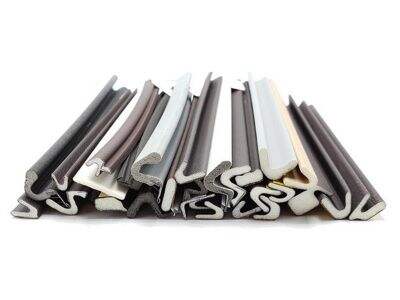Ever noticed a cold draft coming in through a closed door or window? That can be a shock to the system when you thought everything was sealed up tight! This is because most doors and windows have a small space, or gap, between the door or window and its frame. Cold air can seep through that gap, making your home feel chillier than it needs to. But don’t worry! But we've got some solutions to keep your home warm and cozy. That fix is known as weatherstripping.
What is Weatherstripping?
Weatherstripping is a specialized material that seals those tiny spaces around doors and windows. Weatherstripping plugs these holes so air can’t pass in or out of your home. This matters because it aids in maintaining the temperature in your house in winter and summer. Available Types of Weatherstripping Today we are going to cover two primary types: V Strip Weather Seals and Traditional Weatherstipping. You might ask, “Which is better?” Let’s explore together!
Comparing Traditional Weatherstripping to vs. V Strip Weather Seals
This differs from other types of weatherstripping, as V Strip Weather Seals is designed to be inserted into gaps around doors and windows to block air from coming through. They do work in differently unique ways, though.
V Strip Weather Seals are composed of a flexible piece of plastic or rubber in the shape of a "V". When you shut a door or window, the “V” shape squeezes together tight. This forms a tight seal that helps keep the cold air out. It’s like a big warm hug for your door or window!
Traditional Weatherstripping, by contrast, comes in different materials like foam, felt, or metal. It is applied around the perimeter of the door or window opening. This type of weatherstripping also compresses when the door or window is shut. This compression creates a tight seal, protecting your home from pesky drafts.
Which One is Better?
So, you may be thinking, “What type of weatherstripping is right for me?” Pro and Con of V Strip Weather Seals and Traditional Weatherstripping Here are some key considerations:
V Strip Weather Seals:
You don’t even need to be a handyman or handywoman to install them.
These seals are made to last, and save you time and money on replacement.
If you need something to keep the air and water from coming through the door, V Strip Weather Seals are more efficient than Traditional Weatherstripping.
Traditional Weatherstripping:
It provides you with a wider range of materials to choose from. You can choose the one that works best for you!
This type of weatherstrip will be more forgiving if your door or window isn’t perfectly straight. Which means it also can function when everything isn’t pristine.
It is also great for noise and vibration dampening, which can contribute to a quieter, more serene home environment.
Deciding on the type to use is all based on what your needs are. If keeping cold air and water out is your primary concern, you may want to consider V Strip Weather Seals. If however you have not focused your priorities on which without noise and vibrations then Traditional Weatherstripping would be more preferable for you.
How to Pick the Right Weatherstripping
Now that you know the advantages and disadvantages of each type of weatherstripping, how do you choose one in your home? Here are some questions that may help you in making your decision:
What are your priorities? Are you trying to keep the cold air and water out, reduce noise and vibrations, or both? Knowing your primary objectives will help you select the correct kind.
What kind of material do you want? Plastic, rubber, foam, felt, and even metal are among the materials that V Strip Weather Seals and Traditional Weatherstripping are available in. Consider what material would be best suited for your unique door or window.
What is your budget? V Strip Weather Seals and Traditional Weatherstripping are both available for flexible pricing. Maybe now you need to think about how much money should you put in on this project.
After answering these questions, you should have a better understanding of your home and which type of weatherstripping is best!
Conclusion
In conclusion, the V Strip Weather Seals and Traditional Weatherstripping are effective door and window sealing options. V Strip Weather Seals are generally more effective at blocking cold air and water, while Traditional Weatherstripping does a better job of dampening noise and vibrations in your house. When it comes to deciding what type of weatherstripping to use, think about what’s important to you, the type of material you’d like, and your budget. Regardless of which you select, utilizing either V Strip Weather Seals or Traditional Weatherstripping will further your efforts to make your home more comfortable to live in, while doing your part in conserving energy.
Thanks for reading this article! We hope that you learned something new today and feel ready to cosify your home!
 EN
EN AR
AR BG
BG HR
HR CS
CS DA
DA NL
NL FI
FI FR
FR DE
DE EL
EL HI
HI IT
IT JA
JA KO
KO NO
NO PL
PL PT
PT RO
RO RU
RU ES
ES SV
SV TL
TL IW
IW ID
ID UK
UK VI
VI SQ
SQ HU
HU TH
TH TR
TR AF
AF MS
MS BN
BN LO
LO LA
LA MN
MN MY
MY KK
KK
